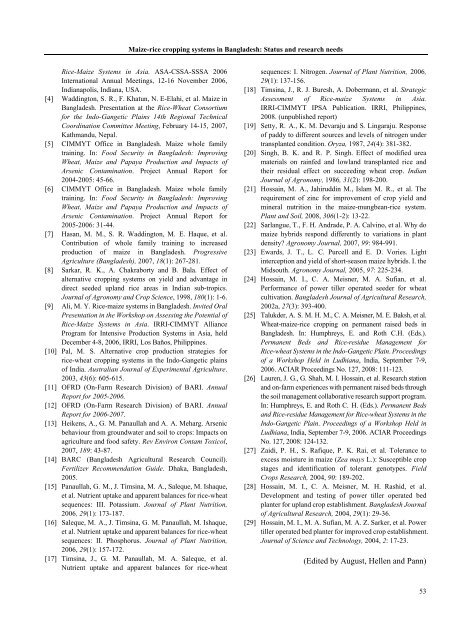Maize-rice cropping systems in Bangladesh - Search CIMMYT ...
Maize-rice cropping systems in Bangladesh - Search CIMMYT ...
Maize-rice cropping systems in Bangladesh - Search CIMMYT ...
You also want an ePaper? Increase the reach of your titles
YUMPU automatically turns print PDFs into web optimized ePapers that Google loves.
<strong>Maize</strong>-<strong>rice</strong> <strong>cropp<strong>in</strong>g</strong> <strong>systems</strong> <strong>in</strong> <strong>Bangladesh</strong>: Status and research needsRice-<strong>Maize</strong> Systems <strong>in</strong> Asia. ASA-CSSA-SSSA 2006International Annual Meet<strong>in</strong>gs, 12-16 November 2006,Indianapolis, Indiana, USA.[4] Wadd<strong>in</strong>gton, S. R., F. Khatun, N. E-Elahi, et al. <strong>Maize</strong> <strong>in</strong><strong>Bangladesh</strong>. Presentation at the Rice-Wheat Consortiumfor the Indo-Gangetic Pla<strong>in</strong>s 14th Regional TechnicalCoord<strong>in</strong>ation Committee Meet<strong>in</strong>g, February 14-15, 2007,Kathmandu, Nepal.[5] <strong>CIMMYT</strong> Office <strong>in</strong> <strong>Bangladesh</strong>. <strong>Maize</strong> whole familytra<strong>in</strong><strong>in</strong>g. In: Food Security <strong>in</strong> <strong>Bangladesh</strong>: Improv<strong>in</strong>gWheat, <strong>Maize</strong> and Papaya Production and Impacts ofArsenic Contam<strong>in</strong>ation. Project Annual Report for2004-2005: 45-66.[6] <strong>CIMMYT</strong> Office <strong>in</strong> <strong>Bangladesh</strong>. <strong>Maize</strong> whole familytra<strong>in</strong><strong>in</strong>g. In: Food Security <strong>in</strong> <strong>Bangladesh</strong>: Improv<strong>in</strong>gWheat, <strong>Maize</strong> and Papaya Production and Impacts ofArsenic Contam<strong>in</strong>ation. Project Annual Report for2005-2006: 31-44.[7] Hasan, M. M., S. R. Wadd<strong>in</strong>gton, M. E. Haque, et al.Contribution of whole family tra<strong>in</strong><strong>in</strong>g to <strong>in</strong>creasedproduction of maize <strong>in</strong> <strong>Bangladesh</strong>. ProgressiveAgriculture (<strong>Bangladesh</strong>), 2007, 18(1): 267-281.[8] Sarkar, R. K., A. Chakraborty and B. Bala. Effect ofalternative <strong>cropp<strong>in</strong>g</strong> <strong>systems</strong> on yield and advantage <strong>in</strong>direct seeded upland <strong>rice</strong> areas <strong>in</strong> Indian sub-tropics.Journal of Agronomy and Crop Science, 1998, 180(1): 1-6.[9] Ali, M. Y. Rice-maize <strong>systems</strong> <strong>in</strong> <strong>Bangladesh</strong>. Invited OralPresentation <strong>in</strong> the Workshop on Assess<strong>in</strong>g the Potential ofRice-<strong>Maize</strong> Systems <strong>in</strong> Asia. IRRI-<strong>CIMMYT</strong> AllianceProgram for Intensive Production Systems <strong>in</strong> Asia, heldDecember 4-8, 2006, IRRI, Los Baños, Philipp<strong>in</strong>es.[10] Pal, M. S. Alternative crop production strategies for<strong>rice</strong>-wheat <strong>cropp<strong>in</strong>g</strong> <strong>systems</strong> <strong>in</strong> the Indo-Gangetic pla<strong>in</strong>sof India. Australian Journal of Experimental Agriculture.2003, 43(6): 605-615.[11] OFRD (On-Farm Research Division) of BARI. AnnualReport for 2005-2006.[12] OFRD (On-Farm Research Division) of BARI. AnnualReport for 2006-2007.[13] Heikens, A., G. M. Panaullah and A. A. Meharg. Arsenicbehaviour from groundwater and soil to crops: Impacts onagriculture and food safety. Rev Environ Contam Toxicol,2007, 189: 43-87.[14] BARC (<strong>Bangladesh</strong> Agricultural Research Council).Fertilizer Recommendation Guide. Dhaka, <strong>Bangladesh</strong>,2005.[15] Panaullah, G. M., J. Tims<strong>in</strong>a, M. A., Saleque, M. Ishaque,et al. Nutrient uptake and apparent balances for <strong>rice</strong>-wheatsequences: III. Potassium. Journal of Plant Nutrition,2006, 29(1): 173-187.[16] Saleque, M. A., J. Tims<strong>in</strong>a, G. M. Panaullah, M. Ishaque,et al. Nutrient uptake and apparent balances for <strong>rice</strong>-wheatsequences: II. Phosphorus. Journal of Plant Nutrition,2006, 29(1): 157-172.[17] Tims<strong>in</strong>a, J., G. M. Panaullah, M. A. Saleque, et al.Nutrient uptake and apparent balances for <strong>rice</strong>-wheatsequences: I. Nitrogen. Journal of Plant Nutrition, 2006,29(1): 137-156.[18] Tims<strong>in</strong>a, J., R. J. Buresh, A. Dobermann, et al. StrategicAssessment of Rice-maize Systems <strong>in</strong> Asia.IRRI-<strong>CIMMYT</strong> IPSA Publication. IRRI, Philipp<strong>in</strong>es,2008. (unpublished report)[19] Setty, R. A., K. M. Devaraju and S. L<strong>in</strong>garaju. Responseof paddy to different sources and levels of nitrogen undertransplanted condition. Oryza, 1987, 24(4): 381-382.[20] S<strong>in</strong>gh, B. K. and R. P. S<strong>in</strong>gh. Effect of modified ureamaterials on ra<strong>in</strong>fed and lowland transplanted <strong>rice</strong> andtheir residual effect on succeed<strong>in</strong>g wheat crop. IndianJournal of Agronomy, 1986, 31(2): 198-200.[21] Hossa<strong>in</strong>, M. A., Jahirudd<strong>in</strong> M., Islam M. R., et al. Therequirement of z<strong>in</strong>c for improvement of crop yield andm<strong>in</strong>eral nutrition <strong>in</strong> the maize-mungbean-<strong>rice</strong> system.Plant and Soil, 2008, 306(1-2): 13-22.[22] Sarlangue, T., F. H. Andrade, P. A. Calv<strong>in</strong>o, et al. Why domaize hybrids respond differently to variations <strong>in</strong> plantdensity? Agronomy Journal, 2007, 99: 984-991.[23] Ewards, J. T., L. C. Purcell and E. D. Vories. Light<strong>in</strong>terception and yield of short-season maize hybrids. I. theMidsouth. Agronomy Journal, 2005, 97: 225-234.[24] Hossa<strong>in</strong>, M. I., C. A. Meisner, M. A. Sufian, et al.Performance of power tiller operated seeder for wheatcultivation. <strong>Bangladesh</strong> Journal of Agricultural Research,2002a, 27(3): 393-400.[25] Talukder, A. S. M. H. M., C. A. Meisner, M. E. Baksh, et al.Wheat-maize-<strong>rice</strong> <strong>cropp<strong>in</strong>g</strong> on permanent raised beds <strong>in</strong><strong>Bangladesh</strong>. In: Humphreys, E. and Roth C.H. (Eds.).Permanent Beds and Rice-residue Management forRice-wheat Systems <strong>in</strong> the Indo-Gangetic Pla<strong>in</strong>. Proceed<strong>in</strong>gsof a Workshop Held <strong>in</strong> Ludhiana, India, September 7-9,2006. ACIAR Proceed<strong>in</strong>gs No. 127, 2008: 111-123.[26] Lauren, J. G., G. Shah, M. I. Hossa<strong>in</strong>, et al. Research stationand on-farm experiences with permanent raised beds throughthe soil management collaborative research support program.In: Humphreys, E. and Roth C. H. (Eds.). Permanent Bedsand Rice-residue Management for Rice-wheat Systems <strong>in</strong> theIndo-Gangetic Pla<strong>in</strong>. Proceed<strong>in</strong>gs of a Workshop Held <strong>in</strong>Ludhiana, India, September 7-9, 2006. ACIAR Proceed<strong>in</strong>gsNo. 127, 2008: 124-132.[27] Zaidi, P. H., S. Rafique, P. K. Rai, et al. Tolerance toexcess moisture <strong>in</strong> maize (Zea mays L.): Susceptible cropstages and identification of tolerant genotypes. FieldCrops Research, 2004, 90: 189-202.[28] Hossa<strong>in</strong>, M. I., C. A. Meisner, M. H. Rashid, et al.Development and test<strong>in</strong>g of power tiller operated bedplanter for upland crop establishment. <strong>Bangladesh</strong> Journalof Agricultural Research, 2004, 29(1): 29-36.[29] Hossa<strong>in</strong>, M. I., M. A. Sufian, M. A. Z. Sarker, et al. Powertiller operated bed planter for improved crop establishment.Journal of Science and Technology, 2004, 2: 17-23.(Edited by August, Hellen and Pann)53
















